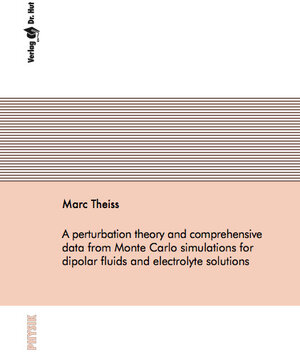
×
![Buchcover ISBN 9783843947039]()
A perturbation theory and comprehensive data from Monte Carlo simulations for dipolar fluids and electrolyte solutions
von Marc TheissThis work proposes perturbation approaches for describing dipolar fluids as well as model and aqueous electrolyte solutions. The electrostatic pair potentials are split into short- and long-ranged contributions, whereas a third order perturbation expansion is applied for the shortranged potentials. This circumvents the problem of divergent correlation integrals. The dipolar perturbation terms are represented through a [2,1]-Padé approximation to resum the poorly convergent series. For the remaining charge–charge and charge–dipole contributions, we present a new approximant, which provides a (quasi)linear dependence of the Helmholtz energy. The underlying correlation integrals are adjusted to results from molecular simulations. The long-ranged contribution to the electrostatic interactions is treated through an analytic expression developed by Rodgers and Weeks [J. Chem. Phys. 131, 244108 (2010)]. Theoretical predictions of our perturbation theory are compared to results from a widely used integral equation theory, namely, the mean spherical approximation, and we find that our perturbation theory provides much more accurate results. Furthermore, the theory shows some quantities in rather good agreement with reference data, namely, Helmholtz energies, internal energies, and densities at higher densities of solutions. Limitations of the approach, however, are observed for several other partial molar quantities, such as the mean activity coefficient.


